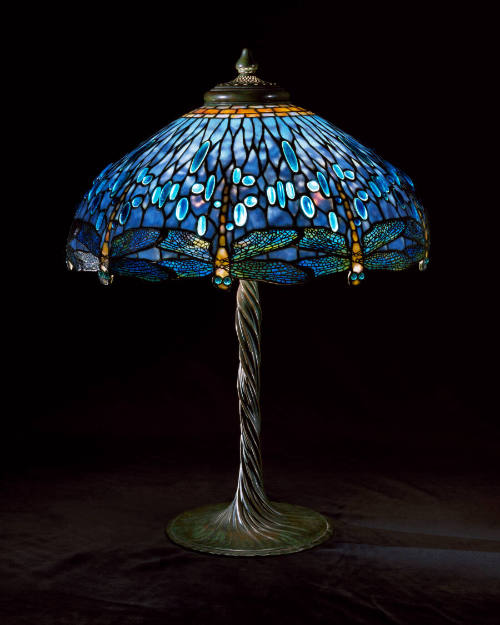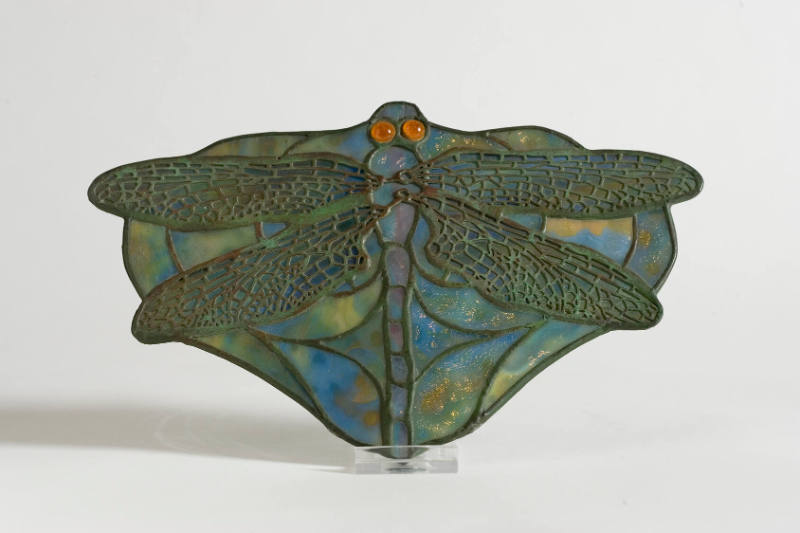- Open today, 10 am to 5 pm.
- Parking & Directions
- Free Admission

Dragonfly Library Lamp
- Twisted Vine
- Lilies
- Dragonflies
- Blue
- Green
- Yellow
- Amber
- Bronze
- Violet
- Chartreuse
- Mauve
- New York
"Work of the Month," Chrysler Museum of Art, Tiffany Glass Gallery, June 2001.
"The Natural Beauty of Tiffany: Selections from the Chrysler Museum," Chrysler Museum of Art, Norfolk, VA, August 18 - December 30, 2012.
American, 1861–1944
Tiffany Studios
New York, 1902–1932
Dragonfly Library Lamp, ca. 1905
Leaded glass with bronze base
Chrysler Museum of Art, Norfolk, VA
Gift of Walter P. Chrysler, Jr. 71.8123
Dragonfly Library Lamp
ca. 1905
Clara Driscoll, attributed designer (shade)American, 1861–1944
Tiffany Studios, manufacturerAmerican, Corona, New York, 1902–32
Leaded glass with bronze base h 27 × diam. 22 in. (68.6 × 55.9 cm)
Marks: "tiffany studios new york 1507," stamped on brass tag, soldered to shade interior; "tiffany studios ny 443," stamped on underside of base
Gift of Walter P. Chrysler, Jr., 71.8123
Louis C. Tiffany produced lighting fixtures for private homes, churches, and public buildings early in his interior decorating career. These fixtures incorporated glass in imaginative and inventive ways, but it wasn’t until the final few years of the nineteenth century that the now-iconic leaded glass "Tiffany lamp" came into being. Tiffany established a glass furnace and bronze foundry in 1893 and 1897, respectively, which allowed him to manufacture lighting fixtures on a large scale and still maintain his exacting standards.1 This positioned him and his studios to create decorative lighting in earnest—a timely development, as electricity had become more widely available and individual wealth more abundant.
Tiffany’s colorful leaded glass lampshades were immediately popular because they were an innovative and successful combination of usefulness and beauty. The lamps were made in all shapes and sizes, and designs ranged from restrained geometric patterns to elaborate floral motifs. The use of opalescent glass, characterized by a milky translucent glow, diffused the harsh electric light of early incandescent bulbs in a warm and pleasing way, making these lamps particularly well suited for intimate domestic settings.
Leaded glass lampshades were made entirely by hand through a multistep process involving designers, glass selectors, cutters, and glaziers. Tiffany’s advertisements emphasized that his lamps were works of art, objects that denoted "the thought of the artist—the execution of the master craftsman."2 Personal correspondence from the manager of the Women’s Glass Cutting Department at Tiffany Studios, Clara Driscoll (1861–1944), reveals the significant role she and the women she supervised (the so-called Tiffany Girls) played in the design and glass selection of these shades, particularly the floral themes. It was Driscoll, in fact, assisted by Alice C. Gouvy (ca. 1870/75–1924), who designed the first dragonfly shade.3 This sixteen-inch cone-shaped lampshade was paired with a bulbous bronze base embellished with glass mosaic and exhibited at the 1900 Exposition Universelle in Paris, where it was awarded a bronze medal for inventive design.4 This first dragonfly shade was undoubtedly the inspiration for the more than ten variations later created by the Tiffany Studios.
Dragonflies were a wildly popular decorative motif at the turn of the twentieth century and the insects quickly proved to be a favorite lamp design among Tiffany’s wealthy clientele. The twenty-two-inch Dragonfly shade, like the one in the Chrysler Museum’s collection, was the firm’s largest and most popular dragonfly table lamp model. It was even a favorite of Tiffany’s; he selected this lampshade for his living room at Laurelton Hall, his grand country estate on the North Shore of Long Island.5
This shade’s straightforward design of nine identical dragonflies allowed for an enormous range of artistic interpretations. Many were made with multicolored backgrounds and glass jewels as well as different colored dragonflies within a single shade. However, the Chrysler’s example—a symphony in blue—offers an entirely different interpretation. The spotted glass in the background is a single color, but has been wonderfully selected to subtly transition from light to dark in order to create movement through shading rather than color change. The background is further enlivened by the use of transparent blue "jewels" that punctuate the opalescent blue glass and further animate the light. The blue and yellow streaky glass in the dragonfly wings harmonizes with the yellow dragonfly bodies and rectangular top border. For its vibrant color, subtle glass selection, and overall harmony, this shade is exemplary. It is the only known example of the twenty-two-inch Dragonfly shade in this color palette. | lrp
Notes
1. The glass furnace and bronze foundry were located in Corona, Queens.
2. Tiffany Studios advertisement, New York Times, December 5, 1906.
3. Clara Driscoll correspondence, March 6, 1899. Collection of the Queens Historical Society, quoted in Martin Eidelberg, Nina Gray, and Margaret K. Hofer, A New Light on Tiffany: Clara Driscoll and the Tiffany Girls (London: D. Giles in association with New-York Historical Society, 2007), 49.
4. Report of the Commissioner-General for the United States to the International Universal Exposition, Paris, 1900, vol. 5 (Washington, DC: Government Printing Office, 1901), 81.
5. For a photograph of the lamp in the living room, see Alastair Duncan, Tiffany Windows (New York: Simon and Schuster, 1980), 161.


